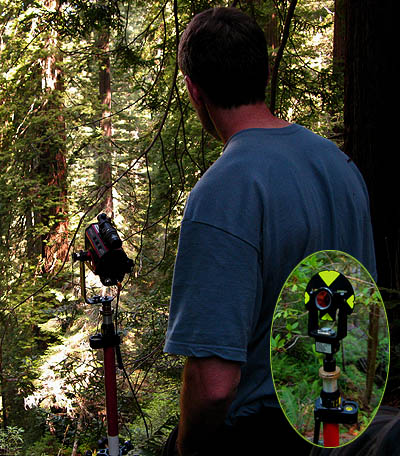
Precision laser rangefinders and measuring redwoods
by Mario Vaden
The photo below shows a Laser Technology Impulse 200 laser rangefinder being used to measure a super tall Sequoia sempervirens in Redwood National Park: image taken 2009.

If you are curious about how redwoods are measured these days for height, this is how its done. Compare this page with: Redwood Dimensions
Other than climbing a redwood to feed measuring tape from the top to bottom, a laser rangefinder like this is the next best thing for accurate measurement of height. In some cases, it is the best thing.
The Impulse rangefinder in the photo has on-board solutions for height, horizontal and vertical distance, and provides distance and inclination. In short, it tells the person using it how far they are from what's being aimed at, even if held at an angle: it detects angles too
These lasers are designed for top performance in the field: lightweight, extremely rugged and waterproof. The Laser Technology model shown, 2009, costs about $3000 and is worth every dime of it.
The rangefinders can be handheld, or mounted on tripods. Then aimed at the highest tip of foliage. That may require going upslope to see the middle of the treetop. The unit detects the angle its held at, and provides the measurements. Basically, it lets the operator know how far over the redwood is horizontally, how tall it is, the angle it was held at, and more. A skilled user knows how to measure the trunk diameter up higher.

The other gadget overlaid in the photo is a Leica surveying prism. These survey prisms are manufactured from high-quality optical glass. All reflective surfaces are have a resistant coating so that reflectivity is not affected badly by dirt or condensation. The surveying prism is convenient mounted on a second tripod to use with the rangefinder, when several measurements are needed to reach the redwood base. The lower trunks are not always in view. Sometimes a half an hour is needed to even walk from where the rangefinder was first aimed at the top, to the final measurement at the base. During this, the rangefinder is aimed at the prism, and all the measurements are either added or subtracted, moving in a leap-frog fashion. In the redwoods, its especially handy to have two people when a rangefinder and prism are used together, because of how long it takes to get from one position to another. Some groves are flat and streamlined with a clear line of sight. But many areas are rugged, steep and heavily covered with shrubs and trees.
There are less expensive laser rangefinders of rather good quality. But for research purposes, a laser rangefinder like this Laser Technology unit really completes the toolbox. Small padded case actually. It weighs just over 2 pounds. Also, there is a remote trigger which adds to accuracy. so the user is not pushing a button on the instrument body. As you can see in the photo, scopes can be mounted on top for the greatest precision.